Hermanson G. Bioconjugate Techniques, Second Edition
Подождите немного. Документ загружается.

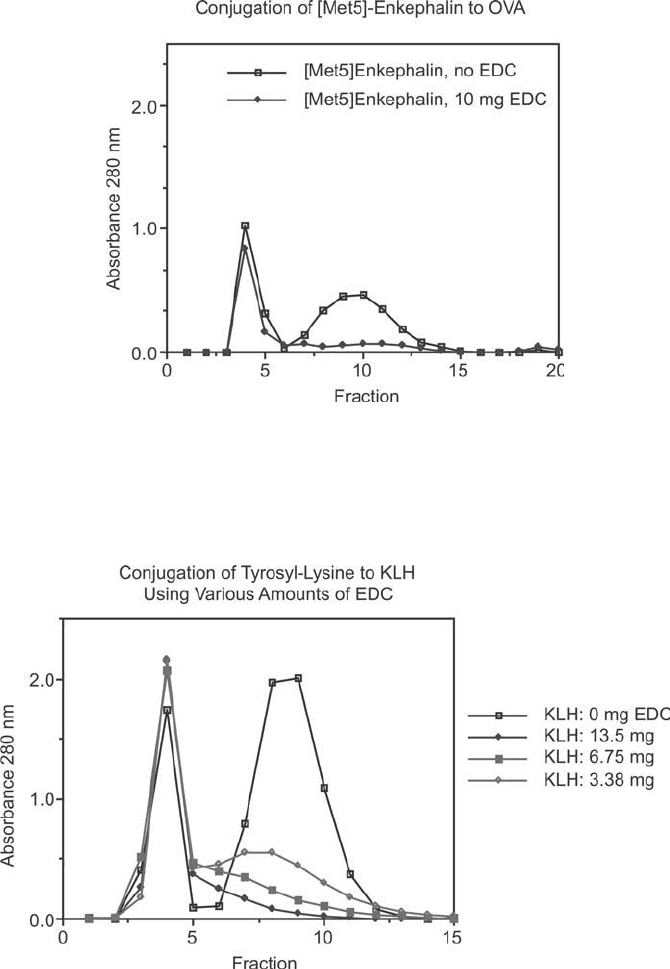
760 19. Preparation of Hapten–Carrier Immunogen Conjugates
Figure 19.10
To illustrate the consistency of an EDC-mediated reaction, [Met5]-enkephalin was conjugated to
OVA using conditions identical to those described for BSA in Figure 19.9. Note the similarity in the degree of
conjugate formation.
Figure 19.11 The EDC conjugation of tyrosyl-lysine to KLH is illustrated by the gel fi ltration pattern on
Sephadex G-25 after the reaction. The fi rst peak is the carrier protein and the second peak is the peptide.
A blank containing no EDC is also shown to provide baseline peak heights that would be obtained if no
crosslinking occurred. When more EDC was added, more peptide was conjugated, as evidenced by peptide peak
depletion.
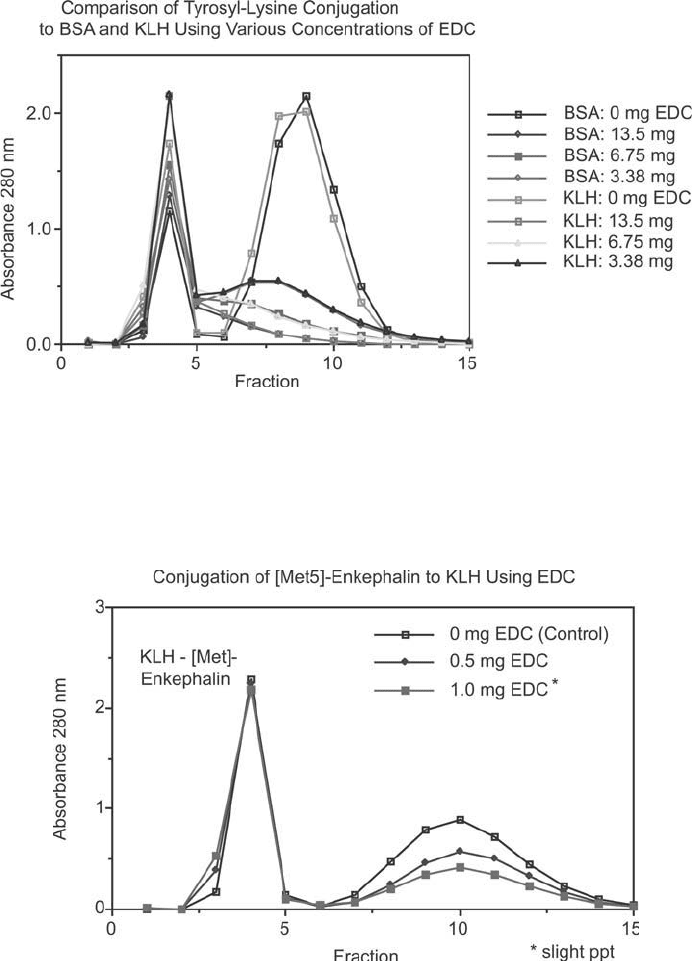
Figure 19.12 EDC conjugation reactions can be extraordinarily consistent using the same peptide crosslinked
to two carrier proteins. This fi gure shows the gel fi ltration pattern on Sephadex G-25 after completion of the
crosslinking reaction. Conjugation of tyrosyl-lysine to BSA and KLH are shown. The fi rst peaks represent elut-
ing carrier, while the second peaks are the excess peptide. Note the consistency of conjugation using the same
levels of EDC addition.
Figure 19.13 Conjugation to KLH often can cause precipitation due to the high-molecular weight of the car-
rier protein. The conjugation of [Met5]-enkephalin to KLH yields a soluble immunogen if the level of EDC
addition is about 0.1 times that typically used with BSA as a carrier. This fi gure shows the gel fi ltration pattern
on Sephadex G-25 after completion of the crosslinking reaction. The fi rst peak is KLH and the second peak is
excess peptide. Depletion of the peptide peak correlates to hapten–carrier conjugation.
3. Carbodiimide-Mediated Hapten–Carrier Conjugation 761
762 19. Preparation of Hapten–Carrier Immunogen Conjugates
resulting from the gel fi ltration separation of KLH and the peptide [Met5]-enkephalin after an
EDC reaction. To result in a soluble immunogen, only 0.1 to 0.2 times the amount of EDC was
added as compared to similar BSA or OVA conjugation reactions. Even at this low levels, how-
ever, the coupling of peptide to the carrier is very effi cient and results in an excellent immunogen.
These studies using EDC-facilitated conjugations were done to develop an optimal protocol
for the preparation of immunogens by carbodiimide crosslinking. For haptens (i.e., peptides)
that display good solubility in aqueous solution, the level of reagent addition should result
in a soluble immunogen conjugate. When using haptens that are sparingly soluble or insolu-
ble in aqueous environments, the conjugation reaction may result in a precipitated complex.
Precipitation often can be controlled by scaling back the level of EDC addition or limiting the
time of the reaction. If a precipitated immunogen is not a problem (most precipitated, high-
molecular weight conjugates are very immunogenic), then the following protocol is applicable
to the great majority of peptide-carrier protein conjugations. Thermo Fisher offers a kit con-
taining all the reagents necessary for an EDC-mediated hapten–carrier conjugation.
Protocol
1. Dissolve the carrier protein in 0.1 M MES, 0.15 M NaCl, pH 4.7, at a concentration
of 10 mg/ml. If using native, multi-subunit KLH, increase the NaCl concentration of
all buffers to 0.9 M (yes, 0.9 M, not 0.9 percent) to maintain solubility of the protein.
If using KLH subunits, the high-salt concentration is not necessary. For neutral pH
conjugations, substitute 0.1 M sodium phosphate, 0.15 M NaCl, pH 7.2, for the MES
buffer.
2. Dissolve up to 4 mg of the peptide or hapten to be coupled in 1.0 ml of the reaction buffer
chosen in step 1. If the peptide to be coupled is already in solution, it may be used directly
if it is in a buffer containing no other amines or carboxylic acids and is at a pH between
4.7 and 7.2.
Note: If an assessment of the degree of peptide coupling is desired, measure the absorbance
at 280 nm of the 1.0 ml peptide solution before proceeding to step 3. In some cases, a dilution
of the peptide solution may be necessary to keep the absorbance on scale for the spectropho-
tometer. If the peptide is sparingly soluble in aqueous solution, it may be dissolve in DMSO
and an aliquot added to the carrier solution. See the previous discussion on carrier proteins
to determine the levels of DMSO compatible with carrier protein solubility. Peptide haptens
should be at least 5–7 amino acids in length to obtain suitable immunogenicity and correct
specifi city of the resulting antibodies produced against them. Many immunogen conjugates use
peptides that are slightly longer than the desired epitopic sequence to provide enough size to
allow interaction with the components of the immune system.
3. Add 500 l of the peptide solution to 200 l of carrier protein. For greater reaction vol-
umes, keep the molar ratio of peptide-to-carrier addition the same and proportionally
scale up the amount of EDC added in the next step. If the peptide is initially dissolved in
DMSO, much less peptide volume compared to protein volume should be used to main-
tain solubility (see discussion in step 2).
4. For conjugations using relatively low-molecular weight proteins, such as BSA or OVA,
add the peptide/carrier solution to a vial containing 10 mg of EDC (Thermo Fisher) and
gently mix to dissolve. For high-molecular weight KLH immunogens, fi rst dissolve one
vial containing 10 mg of EDC in 1 ml of deionized water, and immediately transfer 50 l
of this solution to the carrier/peptide solution. Gently mix.
5. Allow the reaction to continue at room temperature for 2 hours.
Note: Although the conjugation protocols have been optimized by preparing a number of
different peptide-carrier conjugates, some peptide sequences or other haptens may cause pre-
cipitation of the carrier upon coupling. This may occur as a result of changing the carrier ’s sol-
ubility characteristics through surface modifi cation or due to polymerization. A small amount
of precipitation is not a problem and can easily be removed by centrifugation before the gel fi l-
tration step. If severe precipitation occurs, however, the amount of EDC added to the reaction
may have to be scaled back to eliminate or reduce it. With BSA or OVA conjugates, this may
mean using as little as 1–3 mg of EDC instead of the recommended 10 mg. With native, multi-
subunit KLH as a carrier, reducing the EDC levels to 0.1 mg may be necessary.
6. Purify the hapten–carrier conjugate by gel fi ltration or dialysis.
4. NHS Ester-Mediated Hapten–Carrier Conjugation
Hapten–carrier conjugation may be accomplished by the use of homobifunctional reagents con-
taining NHS ester groups on both ends. The active esters are highly reactive toward amines on
proteins and other molecules to form stable amide bonds. Crosslinking agents of various lengths
may be used for this conjugation strategy, including the sulfo-NHS ester analogs which are more
water-soluble than the NHS esters without a sulfonic acid group (Chapter 4, Section 1).
Using homobifunctional NHS esters, amine-containing haptens may be conjugated to amine-
containing carriers in a single step ( Figure 19.14 ). The carrier is dissolved in a buffer having a
pH of 7–9 (0.1 M sodium phosphate, pH 7.2 works well). The hapten molecule is added to this
solution at a suitable molar excess to assure multipoint attachment of the hapten to the carrier.
A molar excess of 20–30 times that of the carrier concentration is a good starting point. Next,
the NHS ester crosslinker is added to the solution to provide at least a 3-fold molar excess
over that of the hapten. For crosslinkers insoluble in aqueous solution, fi rst solubilize them
in dimethylformamide (DMF) or DMSO at higher concentration, and then add an aliquot of
this stock solution to the hapten–carrier solution. The conjugation reaction is complete within
2 hours at room temperature. Some adjustment of the level of hapten and crosslinker addi-
tion may be necessary to avoid extensive precipitation of the conjugate, especially when using
rather hydrophobic hapten molecules.
Another method of NHS ester-mediated hapten–carrier conjugation is to create reactive sulfo-
NHS esters directly on the carboxylates of the carrier protein using the EDC/sulfo-NHS reac-
tion described in Chapter 3, Section 1.2. A carbodiimide reaction in the presence of sulfo-NHS
activates the carboxylate groups on the carrier protein to form amine-reactive sulfo-NHS esters.
The activation reaction is done at pH 6.0, since the amines on the protein will be protonated
and therefore be less reactive toward the sulfo-NHS esters that are formed. In addition, the
hydrolysis rate of the esters is dramatically slower at acid pH. Thus, the active species may be
isolated in a reasonable time frame without signifi cant loss in conjugation potential. To quench
unreacted EDC, 2-mercaptoethanol is added to form a stable complex with the remaining
carbodiimide, according to Carraway and Triplett (1970). In the following protocol, a modifi -
cation of Grabarek and Gergely ’s (1990) two-step method, sulfo-NHS is used instead of NHS
4. NHS Ester-Mediated Hapten–Carrier Conjugation 763
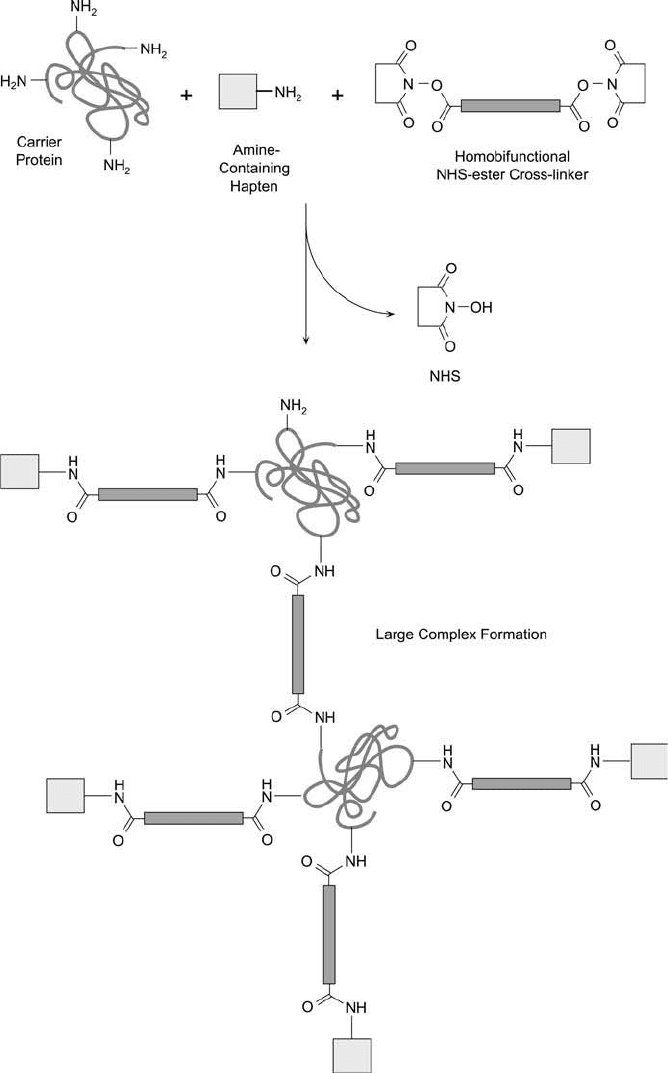
Figure 19.14 Hapten–carrier immunogen conjugates can be formed using homobifunctional NHS ester crosslink-
ers. The reaction may create large polymeric complexes, some of which could precipitate.
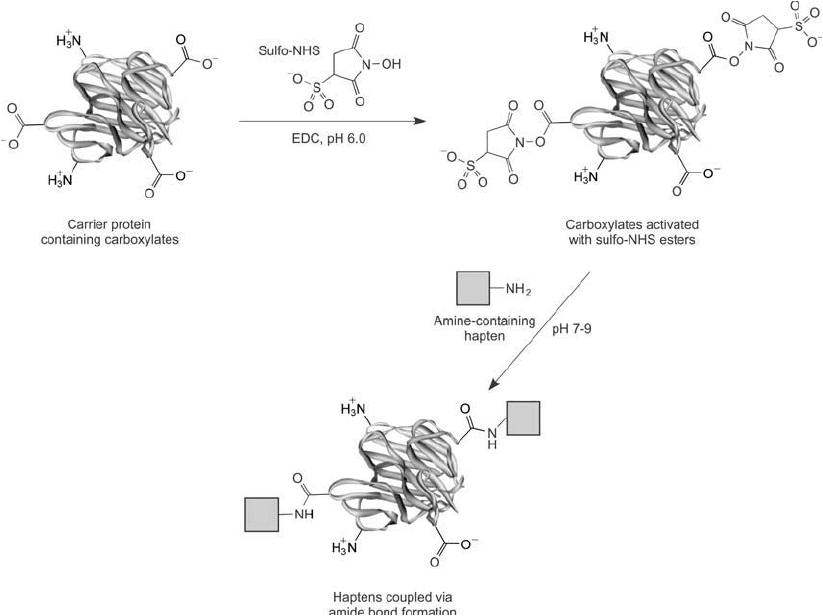
so that active ester hydrolysis is slowed even more (Anjaneyulu and Staros, 1987; Thelen and
Deuticke, 1988). Subsequent conjugation with amine-containing hapten molecules yields
hapten–carrier conjugates created by amide bond formation ( Figure 19.15 ).
Protocol
1. Dissolve the carrier protein to be activated in 0.05 M MES, 0.5 M NaCl, pH 6.0 (reac-
tion buffer), at a concentration of 1 mg/ml.
2. Add to the solution in step 1 a quantity of EDC and sulfo-NHS (both from Thermo
Fisher) to obtain a concentration of 2 mM EDC and 5 mM sulfo-NHS. To aid in aliquot-
ing the correct amount of these reagents, they may be quickly dissolved in water at a
higher concentration, and then immediately a volume pipetted into the protein solution
to obtain the proper molar quantities.
3. Mix and react for 15 min at room temperature to form the sulfo-NHS esters.
4. Add 2-mercaptoethanol to the reaction solution to obtain a fi nal concentration of
20 mM. Mix and incubate for 10 min at room temperature.
4. NHS Ester-Mediated Hapten–Carrier Conjugation 765
Figure 19.15 The carbodiimide EDC can be used in the presence of sulfo-NHS to create reactive sulfo-NHS
ester groups on a carrier protein. Subsequent coupling with an amine-containing hapten can be done to create
amide bond linkages.
766 19. Preparation of Hapten–Carrier Immunogen Conjugates
Note: if the protein being activated is sensitive to this level of 2-mercaptoethanol, instead
of quenching the reaction chemically, the activation may be terminated by rapid desalting (see
step 5).
5. If the reaction was quenched by the addition of 2-mercaptoethanol, the activated pro-
tein may be added directly to an amine-containing hapten molecule for conjugation.
Alternatively, or if no 2-mercaptoethanol was added, the activated protein may be puri-
fi ed from reaction by-products by gel fi ltration using a desalting resin. The desalting
operation should be done rapidly to minimize hydrolysis and recover as much active
ester functionality as possible. The use of centrifugal spin columns may afford the great-
est speed in separation (Thermo Fisher). After purifi cation, add the activated protein to
the hapten for conjugation. The hapten molecule should be dissolved in 0.1 M sodium
phosphate, pH 7.5.
6. React for at least 2 hours at room temperature.
7. Remove excess reactants by gel fi ltration or dialysis.
5. NHS Ester-Maleimide Heterobifunctional Crosslinker-Mediated
Hapten–Carrier Conjugation
A common method for coupling haptens to carrier proteins involves the use of a heterobifunc-
tional crosslinker containing an NHS ester and a maleimide group. This type of crosslinker
allows better control over the coupling process than homobifunctional or zero-length conjuga-
tion methods by incorporating a 2- or 3-step reaction strategy directed against two different
functional targets. In this approach, the carrier protein fi rst is activated with the crosslinker
through its amine groups, purifi ed to remove excess reactants, and then crosslinked to a hapten
molecule containing a sulfhydryl group. One of the most useful reagents for this conjugation
approach is sulfo-SMCC.
The reactions associated with a sulfo-SMCC conjugation are shown in Figure 19.16
(Note: sulfo-SMCC is sulfosuccinimidyl-4-( N-maleimidomethyl) cyclohexane-1-carboxylate;
MW 436.37) (see Chapter 5, Section 1.3). This crosslinking reagent mediates the conjuga-
tion of a carrier protein through its primary amine groups to a peptide or other hapten through
sulfhydryl groups. The active N-hydroxysulfosuccinimide ester (sulfo-NHS) end of sulfo-
SMCC fi rst is reacted with available primary amine groups on the carrier protein. This reac-
tion results in the formation of an amide bond between the protein and the crosslinker with
the release of sulfo-NHS as a by-product. The carrier protein is then isolated by gel fi ltration to
remove excess reagents. At this stage, the purifi ed carrier possesses modifi cations generated by
the crosslinker resulting in a number of reactive maleimide groups projecting from its surface.
The maleimide portion of sulfo-SMCC is a thiol-reactive group that can be used in a secondary
step to conjugate with a free sulfhydryl (i.e., a cysteine residue) on a peptide or other hapten,
resulting in a stable thioether bond.
The use of sulfo-SMCC over the other common maleimide-containing crosslink-
ers such as m -Maleimidobenzoyl- N-hydroxysuccinimide ester (MBS) or succinimidyl-4-
(p-maleimidophenyl)butyrate (SMPB) provides the advantages of initial water-solubility during
the activation step and increased stability of the maleimide group prior to conjugation with a
peptide. The improved stability assures that the majority of the maleimide groups substituted
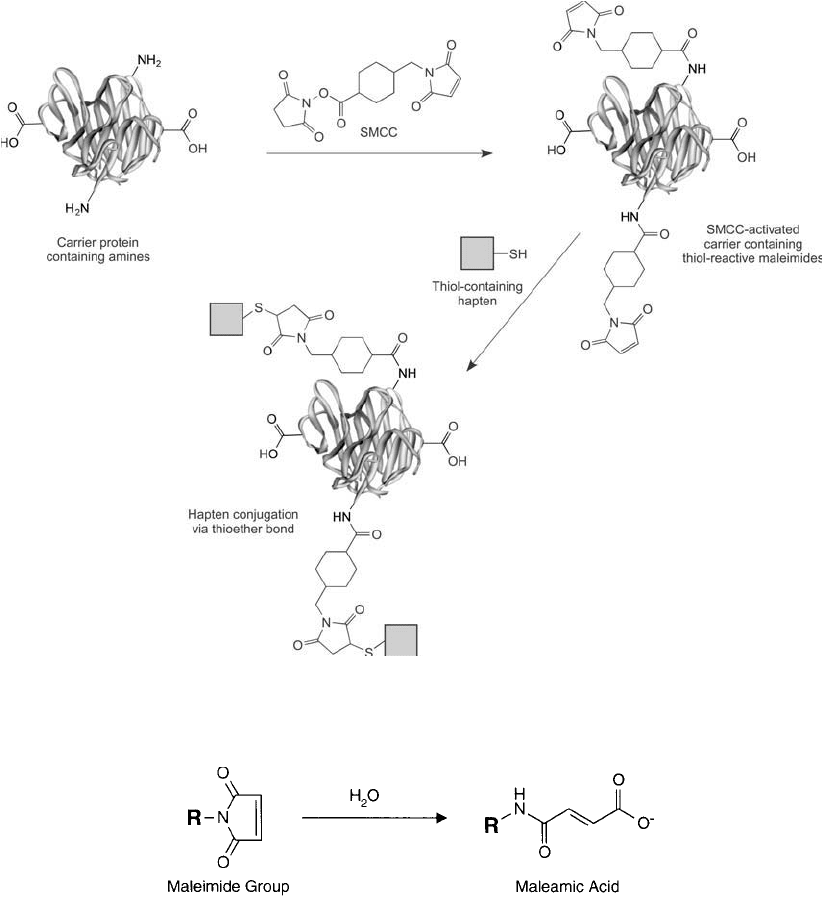
on the carrier will survive the subsequent purifi cation process without degradation. The rela-
tively good stability of the maleimide group of sulfo-SMCC is probably due to the neighbor-
ing steric effects of its cyclohexane ring. The faster hydrolysis rates of other maleimide type
crosslinkers can be a signifi cant problem, since they readily break down to the maleamic acid
form, which is no longer reactive toward sulfhydryls ( Figure 19.17 ).
Figure 19.16 A common way of conjugating sulfhydryl-containing haptens to carrier proteins is to activate
the carrier with sulfo-SMCC to create an intermediate maleimide derivative. The maleimide groups then can be
coupled to thiols to form thioether bonds.
Figure 19.17 A maleimide group may hydrolyze in aqueous solution to an open maleamic acid form that is
unreactive with sulfhydryls.
5. NHS Ester-Maleimide Heterobifunctional Crosslinker-Mediated Hapten–Carrier Conjugation 767
768 19. Preparation of Hapten–Carrier Immunogen Conjugates
A disadvantage to using SMCC or other NHS–maleimide type crosslinkers with hindered
ring structures (such as MBS) is the relatively high immunogenicity of the cross-bridge. Studies
have shown that a hapten–carrier complex formed from such crosslinkers generates signifi cant
antibody response against the spacer group itself, not just the hapten and carrier. To minimize
the antibody population directed against the cross-bridge of the conjugate, the use of aliphatic
straight-chain spacers will exhibit lower immunogenicity (Peeters et al., 1989). However, per-
haps a better choice for this type of conjugation is a polyethylene glycol (PEG) based crosslinker
containing an NHS ester on one end and a maleimide group on the other end (see Chapter 18,
Section 2). A PEG group used as a cross-bridge in a heterobifunctional reagent to prepare
immunogen conjugates will result in non-immunogenic modifi cations on the carrier protein and
thus no antibody production against the polyether linker. Although SMCC (or sulfo-SMCC)
is used in the following protocol, direct substitution of a PEG-based crosslinker will limit the
immune response to the hapten, and not generate unwanted antibodies to the cross-bridge.
Since many peptides do not naturally contain cysteine residues with free sulfhydryls, a terminal
cysteine may be incorporated during peptide synthesis, or where appropriate, disulfi de groups
may be reduced to generate them. Alternatively, thiolating reagents such as 2-iminothiolane
(Traut ’s reagent) can be used to modify existing amino groups and introduce a sulfhydryl (see
section 1.1.4.1). Caution must be taken when using this last technique, however, because mul-
tiple sites of modifi cation may alter the immunogenic structure of the hapten.
If a terminal cysteine residue is added to a peptide during its synthesis, its sulfhydryl group
provides a highly specifi c conjugation site for reacting with a sulfo-SMCC-activated carrier. All
peptide molecules coupled using this approach will display the same basic conformation after
conjugation. In other words, they will have a known and predictable orientation, leaving the
majority of the molecule free to interact with the immune system. This method therefore can
preserve the major epitopes on a peptide while still enhancing the immune response to the hap-
ten by being covalently linked to a larger carrier protein. In addition, the well-known chemical
reactivity of a sulfo-SMCC-mediated immunogen preparation permits covalent conjugation in
a controllable fashion that can be highly defi ned for quality assurance purposes.
The process of carrier activation by sulfo-SMCC may be followed by performing a simple
purifi cation step after the reaction using a desalting resin. Figure 19.18 shows the gel fi ltration
profi les for the separation of sulfo-SMCC-activated BSA and OVA. The fi rst peak of both sepa-
rations represents the elution point for the carrier protein, while the absorbance due to reaction
by-products of the crosslinker is contained in the second peak (shown only as its leading edge).
Activated proteins exhibit an increase in their absorbance at 280 nm over an identical sample
with no added sulfo-SMCC due to their covalently attached maleimide groups. After isolation,
the activated protein may be frozen and lyophilized to preserve maleimide coupling activity
toward sulfhydryl-containing haptens. Thermo Fisher sells a number of maleimide-activated
carrier proteins in lyophilized form for easy hapten conjugation.
After a carrier protein has been activated with sulfo-SMCC, it is often useful to measure
the degree of maleimide incorporation prior to coupling an expensive hapten. Ellman ’s reagent
may be used in an indirect method to assess the level of maleimide activity of sulfo-SMCC-
activated proteins and other carriers. First, a sulfhydryl-containing compound such as
2-mercaptoethanol or cysteine is reacted in excess with the activated protein. The amount of
unreacted sulfhydryls remaining in solution is then determined using the Ellman ’s reaction
(Chapter 1, Section 4.1). Comparison of the response of the sample to a blank reaction using
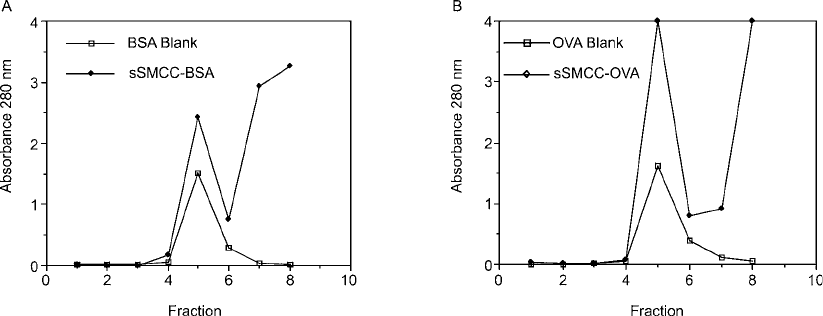
the native, non-activated protein at the same concentration and a series of standards made
from a serial dilution of the sulfhydryl compound employed in the assay gives the amount of
sulfhydryl compound conjugated and thus an estimate of the original maleimide activity.
Figure 19.19 shows a plot of the results of such an assay done to determine the maleim-
ide content of activated BSA. This particular assay used 2-mercaptoethanol which is relatively
unaffected by metal-catalyzed oxidation. For the use of cysteine or cysteine-containing peptides
in the assay, however, the addition of EDTA is required to prevent disulfi de formation. Without
the presence of EDTA at 0.1 M, the metal contamination of some proteins (especially serum
proteins such as BSA) is so great that disulfi de formation proceeds preferential to maleimide
coupling. Figure 19.20 shows a similar assay for maleimide-activated BSA using the more
innocuous cysteine as the sulfhydryl-containing compound.
Using this type of cysteine-uptake assay, it is possible to determine the percentage of maleimides
that reacted over time. Thus, an indication of the reaction effi ciency of a sulfhydryl-containing
compound coupling with a maleimide-activated protein may be determined. Figure 19.21 shows
the reaction rate for the coupling of cysteine to maleimide-activated BSA. Note that maximal
coupling is obtained in less than 2 hours, and over 80 percent yield is achieved in less than
30 minutes.
The following protocol describes the activation of a carrier molecule with sulfo-SMCC
and its subsequent conjugation with a hapten. The preactivated carriers containing maleimide
groups ready for coupling to a sulfhydryl-containing compound are commercially available in a
stable freeze-dried form (Thermo Fisher). Substitution of GMBS (Chapter 5, Section 1.7) or an
NHS-PEG-maleimide crosslinker (Chapter 18, Section 2) in the following protocol will provide
straight-chain spacer arms with lower or no immunogenicity compared to the ring structure of
SMCC’s cross-bridge.
Figure 19.18 Carrier proteins may be activated with sulfo-SMCC to produce maleimide derivatives reactive
with sulfhydryl-containing molecules. The graphs show the gel fi ltration separation on Sephadex G-25 of male-
imide-activated BSA (A) and OVA (B) after reaction with sulfo-SMCC. The fi rst peak is the protein and the
second peak is excess crosslinker. The maleimide groups create increased absorbance at 280 nm in the activated
proteins.
5. NHS Ester-Maleimide Heterobifunctional Crosslinker-Mediated Hapten–Carrier Conjugation 769
